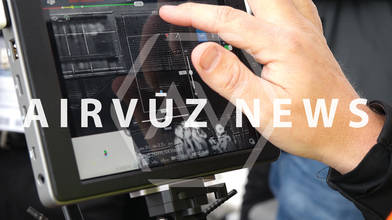
AV NEWS: DJI's Enterprise Ambitions
- over 7 years ago
- 821 VŪZ
28 



- 13
- Report
DJI has been in the drone industry for more than a decade, introducing thousands of pilots to the world of drones through its popular hobbyist models. But it wasn’t until recent years that the drone manufacturer branched out to incorporate commercial and agricultural drones into its fleet. “We have since grown to be one of the biggest drone players in the industry on the enterprise side, which is what AUVSI is all about with the commercial and industrial drones. This has been a growing category for us, but really over the last I’d say two years, it’s really gotten to be a big deal," Senior Communications Manager at DJI Michael Oldenburg explained. DJI’s booth at the AUVSI Xponential show in Denver last week was among the most popular for attendees. In the flight cage, the company’s camera drones like the Mavic were flown for demonstrations. But some of their newer, more high-tech equipment was on display on the roof of the Colorado Convention Center. That’s where the company’s thermal imaging camera could be seen. “What’s new about this, it’s called the Zenmuse XT2, it’s a side-by-side visual and thermal within the same camera. So you can easily, if you’re a drone pilot, flip between thermal and the visual sensors and you can actually, using some of FLIR’s patented technology, overlay those two images and you get a blended image, which is really useful if you’re trying to quickly identify hotspots but also keep your situational awareness while you’re flying," said Oldenburg. The Zenmuse XT2, created in partnership with thermal imaging company FLIR, was just one of several eye-catching products from DJI’s Enterprise line at last week’s expo. These drones are being used for things like inspections, surveying, public safety and more. The biggest drone on display was DJI’s Agras MG-1S, the company’s foray into agriculture. The MG-1S has a flight time of 10 minutes and can spray fertilizer or pesticides with precision. Though its use is not yet allowed in the United States, Xponential’s international audience was drawn to its potential. “Especially in markets like Asia or China, for us, where a lot of the land may be terraced and inaccessible to modern-day machinery, a lot of spraying is done by hand by people wearing backpacks and hand sprayers. If you can get them out of the field and get them away from some of those potentially toxic chemicals using drones, it’s a great solution," said Oldenburg. Oldenburg also noted software developments in DJI’s Enterprise line. One standout upgrade is a payload software development kit. The kit allows users to create custom sensors that work with some of DJI’s Enterprise line of drones. These custom sensors could be used to detect soil damage in crops or water line issues in cities, for example. DJI has long controlled a large percentage of the hobbyist market. Some estimate as much as 75 percent of the hobby drones in operation today are made by DJI. The company’s hope now is to continue to make a name for itself in the industrial and agricultural drone space as well. “As more consumers started to fly drones, this is where we see a lot of innovation in the industry happening. A little light bulb might go off in their head saying, ‘You know what, I can use this drone for this purpose in my business, my actual day job.’ It was the early adopters, the consumer drone fliers, that really started to bring the drone technology into the enterprise. So we’ve just seen that natural progression,” said Oldenburg. See AirVūz News' full coverage of the AUVSI Xponential show HERE. Follow AirVūz News for more stories about the people, technology, and updates shaping the drone industry.
Up Next
FPV Pilots to Watch - 11/28/25

- AirVuzFPV
- 4 VŪZ
0 - 0
- 24 minutes ago
Drone Video of the Month, November (2025)

- Drone Video Contests
- 382 VŪZ
1 - 1
- 2 days ago
Drone Video of the Week, Episode 47 (2025)

- Drone Video Contests
- 233 VŪZ
1 - 0
- 4 days ago
FPV Pilots to Watch - 11/21/25

- AirVuzFPV
- 281 VŪZ
0 - 0
- 7 days ago
Announcing: AirVuz 2025 Drone Video of the Year Contest

- AirVūz Official
- 332 VŪZ
7 - 4
- 9 days ago
Drone Video of the Week, Episode 46 (2025)

- Drone Video Contests
- 649 VŪZ
1 - 1
- 11 days ago
FPV Pilots to Watch - 11/14/25

- AirVuzFPV
- 403 VŪZ
0 - 0
- 18 days ago
Drone Video of the Week, Episode 45 (2025)

- Drone Video Contests
- 901 VŪZ
1 - 0
- 18 days ago
FPV Pilots to Watch - 11/07/25

- AirVuzFPV
- 287 VŪZ
0 - 0
- 22 days ago
Drone Video of the Week, Episode 44 (2025)

- Drone Video Contests
- 749 VŪZ
1 - 1
- 25 days ago

